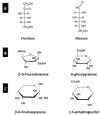High-Fructose-Induced Salt-Sensitive Hypertension: The Potential Benefit of SGLT4 or SGLT5 Modulation
- PMID: 40806096
- PMCID: PMC12348421
- DOI: 10.3390/nu17152511
High-Fructose-Induced Salt-Sensitive Hypertension: The Potential Benefit of SGLT4 or SGLT5 Modulation
Abstract
Hypertension is an important risk factor for cardiovascular diseases. High salt intake when consumed with excess fructose enhances hypertension and resultant cardiovascular disease. Usually, the small intestine absorbs dietary fructose, and the proximal tubule of kidney reabsorbs filtered fructose into the circulation with the help of different transporters including SGLT4 and SGLT5. Very recently, SGLT5 mRNA has also been found to be expressed in the heart. High-fructose diet stimulates the sympathetic nervous system and renin-angiotensin-aldosterone (RAAS) activity, of which both are responsible for endothelial dysfunction and are associated with salt-sensitive hypertension. Few studies exist regarding the effects of SGLT4 and SGLT5 on cardiovascular function and blood pressure. However, SGLT4 gene knockout does not alter fructose-associated impact on blood pressure. In contrast, blood pressure does not increase in SGLT5 knockout rats even during fructose consumption. Given that limiting fructose and salt consumption as a public health strategy has proven challenging, we hope that studies into SGLT4 and SGLT5 transporters will open new research initiatives to address salt-sensitive hypertension and cardiovascular disease. This review highlights current information about SGLT4 and SGLT5 on fructose absorption, salt-sensitive hypertension, cardiovascular disease and points the way for the development of therapeutic fructose inhibitors that limit adverse effects.
Keywords: SGLT4; SGLT5; diet; fructose; hypertension; prevention; salt.
Conflict of interest statement
All authors declare that there are no relationships or activities that could appear to have influenced the submitted work.
Figures






Similar articles
-
Knocking Out Sodium Glucose-Linked Transporter 5 Prevents Fructose-Induced Renal Oxidative Stress and Salt-Sensitive Hypertension.Hypertension. 2024 Jun;81(6):1296-1307. doi: 10.1161/HYPERTENSIONAHA.123.22535. Epub 2024 Mar 28. Hypertension. 2024. PMID: 38545789 Free PMC article.
-
Replacing salt with low-sodium salt substitutes (LSSS) for cardiovascular health in adults, children and pregnant women.Cochrane Database Syst Rev. 2022 Aug 10;8(8):CD015207. doi: 10.1002/14651858.CD015207. Cochrane Database Syst Rev. 2022. PMID: 35944931 Free PMC article.
-
Prescription of Controlled Substances: Benefits and Risks.2025 Jul 6. In: StatPearls [Internet]. Treasure Island (FL): StatPearls Publishing; 2025 Jan–. 2025 Jul 6. In: StatPearls [Internet]. Treasure Island (FL): StatPearls Publishing; 2025 Jan–. PMID: 30726003 Free Books & Documents.
-
Effects of low sodium diet versus high sodium diet on blood pressure, renin, aldosterone, catecholamines, cholesterol, and triglyceride.Cochrane Database Syst Rev. 2020 Dec 12;12(12):CD004022. doi: 10.1002/14651858.CD004022.pub5. Cochrane Database Syst Rev. 2020. PMID: 33314019 Free PMC article.
-
Altered dietary salt intake for people with chronic kidney disease.Cochrane Database Syst Rev. 2015 Feb 18;(2):CD010070. doi: 10.1002/14651858.CD010070.pub2. Cochrane Database Syst Rev. 2015. Update in: Cochrane Database Syst Rev. 2021 Jun 24;6:CD010070. doi: 10.1002/14651858.CD010070.pub3. PMID: 25691262 Updated.
References
-
- Pereira R.M., Botezelli J.D., da Cruz Rodrigues K.C., Mekary R.A., Cintra D.E., Pauli J.R., da Silva A.S.R., Ropelle E.R., de Moura L.P. Fructose Consumption in the Development of Obesity and the Effects of Different Protocols of Physical Exercise on the Hepatic Metabolism. Nutrients. 2017;9:405. doi: 10.3390/nu9040405. - DOI - PMC - PubMed
Publication types
MeSH terms
Substances
Grants and funding
LinkOut - more resources
Full Text Sources
Medical

